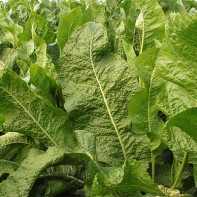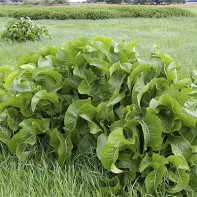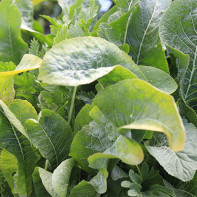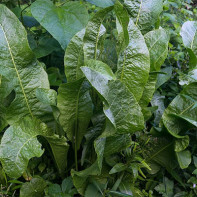Horseradish leaves: medicinal properties and contraindications
Horseradish can safely be called a Russian traditional plant. Its history goes back several millennia. He is popular in our time. Seasonings made from a vigorous plant belong to the national Russian cuisine. Horseradish is used not only in cooking, but also in other areas due to its valuable composition. And it’s not difficult to grow it, since the vegetable is unpretentious and grows quickly on a personal plot.
- Chemical composition
- How it looks and where it grows
- Habitat
- Varieties and types
- Landing and care
- Collection and storage
- How to distinguish horseradish from horse sorrel
- Useful properties of horseradish leaves
- For women
- For men
- When losing weight
- Cooking Application
- Horseradish leaves in folk medicine
- Compress
- Bathing with foliage
- With osteoporosis
- With neuralgia
- With varicose veins
- With mastopathy
- For lumbar pain
- Types of healing compounds
- Infusion
- Tincture
- Decoction
- Tea
- Ointment
- Application in cosmetology
- For aging skin
- With cellulite
- For hair growth
- To get rid of the cut ends
- For dry hair
- Can rabbits and chickens be given horseradish leaves
- Contraindications
In the article we will talk about the benefits of horseradish, in particular its leaves, find out what diseases can help, how it is used in folk medicine, what can be prepared from a plant, how does it affect the duration of storage of other products.
We begin the story of a unique vegetable perennial with a chemical composition.
Chemical composition
No wonder this culture is called a natural antibiotic. This is explained by the high content of phytoncides in horseradish. These are substances that successfully fight germs and various infections. They are classified as synthetic antibiotics.
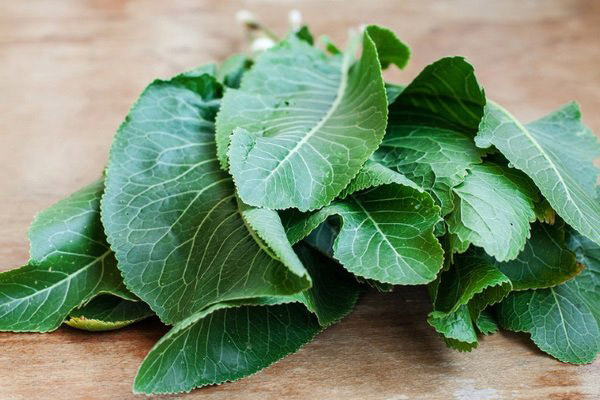
One of the main advantages of the plant is that it does not need to be found in stores. It is enough to plant in the country or collect on the road. Horseradish is found almost everywhere: near houses, in neglected areas, in meadows, in yards, along the banks of water bodies, in willow trees, etc. But if you want to grow yourself, then nothing is easier. He has root reproduction, he is not whimsical to the conditions of cultivation and care, which indicates his energy power.
As early as the 17th century, healers tried to treat them with cancer. In the medical books of the XVIII century, the plant was given special significance and used it as:
- diuretic;
- anthelmintic;
- anti-inflammatory;
- blood-regulating, blood-restoring and blood-purifying;
- anti-zingotic agent.
This is all due to the fact that in culture there are many useful substances for the human body. It is worth noting that horseradish is a low-calorie product, but it tends to increase appetite. It (based on 100 g) contains:
- kcal - 59;
- proteins - 1.18;
- fiber - 3.3;
- carbohydrates - 11.29;
- fat - 0.69.
If we talk about macro- and microelements, vitamins, minerals, then the plant contains:
- pyrodoxin;
- folates;
- pantothenic acid;
- niacin;
- thiamine;
- riboflavin, etc.
Vitamins of the group: A, PP, C, etc. It is worth noting that horseradish is several times faster than lemon in terms of ascorbic acid content.
Items:
- copper;
- sodium;
- iron;
- phosphorus;
- potassium;
- zinc;
- magnesium;
- calcium;
- lutein;
- carotene, etc.
Mustard and essential oils contained in it give special taste qualities to horseradish. Juice contains a lot of lysozin, which can resist harmful infections and viruses. It improves appetite and promotes the release of juice in the stomach, as does allyl oil.
The root, like the leaves, is rich in vitamin C. They do not lose their medicinal properties, and vitamins are stored in the product for up to six months. But if the peeled roots are ground, then the loss of vitamin will be inevitable. Grated horseradish contains only the remains of ascorbic acid. Therefore, in order to preserve the value of the product, you must immediately add acetic acid. This will not only preserve vitamin C, but also give the seasoning special taste. There is a lot of carotene in the leaves of plants!
It is safe to say that a vegetable that is inconspicuous at first glance is a storehouse of mineral, biologically active elements and vitamins.
How it looks and where it grows
Horseradish refers to perennials. This is an ordinary culture related to the cabbage family. It has a thickened and fleshy root, which plays a special role in folk medicine. Small lateral roots depart from the rhizome, which in their healing qualities are not inferior to the root itself, but even surpass it.
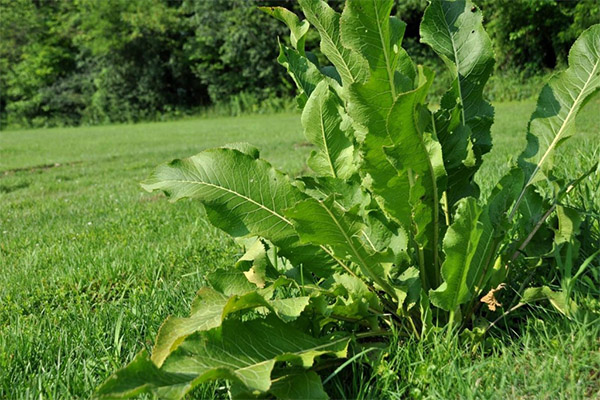
Distinctive features of the plant:
- The stem in length can reach a meter and above. It is straight and rather branched.
- Leaves have different shapes and sizes. Below they are larger, reach a diameter of 40 cm, in shape - pinnately separate with a wavy edge. At the top, the leaves have an oblong shape, they are much smaller in size.
- Flowers are collected in a small brush of white color at the top of the plant. Flowering begins in late spring - May, ends in mid-summer - June. The plant can not always bloom, while remaining with only basal leaves.
- Fruits are small in size.
Habitat
For this culture, habitual habitats are wetlands such as floodplains and riverbanks, meadows, bushes, etc. You can often see horseradish along the land where he lives as a weed. It grows both in the middle lane of our country and in Siberia.
It is worth noting that this wild plant first appeared in Europe. It is the European southwestern part that is considered the birthplace of horseradish. Germans began to cultivate perennial in the Middle Ages.
Varieties and types
Horseradish has several varieties and types. In Russia, there are:
- Meadow view.
- Ordinary.
The first grows in Siberia, the second - in the central part of the Russian Federation. When deciding to grow a useful crop on your site, you need to choose varieties that are appropriate for the climate.
Important! Varietal seeds intended for cultivation in the middle lane will not take root in Siberia. It is necessary to pay attention to the characteristics of the chosen variety: when to plant, when to collect, etc.
Of the varieties it is worth highlighting:
- Rostov
- Suzdal.
These are the varieties grown by local vegetable growers. Of the ones that are especially valued:
- Marune;
- Atlant
- Wild or Valkovsky.
The culture should not be grown in the same place for more than 3 years, otherwise the rhizome will harden, and it can not be eaten. It is enough to keep it on the same bed for 2 years, so that horseradish is always useful both as food and as a medicine.
Important! For perennial, appropriate care is necessary so that the plant does not grow wild and does not begin to grow anywhere. This can lead to clogging of the land and crowding out other crops from it.
Landing and care
The place for planting horseradish is better to choose darkened. The landing time can be different - both in autumn and early spring.
Interesting fact! It is important to plant the root in the position in which it grew earlier. In order not to get confused, it is necessary to make small “tips” for harvesting: digging the rhizome, make different cuts on it from the bottom and top. For example, at the top, make an even cut, and on the other hand, beveled.
When planting, you must observe a distance of at least 40 cm between the plants themselves and 70 between rows. The root should not be deepened, it will be enough from above 5 cm of land. They are placed in the ground at an angle of about 45 degrees.
The culture does not require special care. It is enough to water it so that the earth is not very dry, to conduct timely weeding and loosening. You can add a little organics to the soil in the fall. When the root takes root, sprouts, it is desirable to fertilize the ground. Potash and nitrogen fertilizers are ideal for this. You can feed the soil during the growth of horseradish, but you can completely do without it. As we have said, the plant is unpretentious and does not require special care.
Collection and storage
Harvested, as expected, in the fall, in the middle or end of October.Can be collected in early spring. The most delicious root crops are two-year or three-year-olds. Harvesting begins with leaf cutting. Then they dig up the earth with a pitchfork and manually get the horseradish out of it. You may have to do a deep digging, as some rhizomes can go far inland. Then it is necessary to sort into large, medium and small specimens. For storage, even and large fruits are suitable. Small can be re-planted in the spring.
For harvesting, the rhizome is cleaned of earth and dirt, cut off small growths and wormy parts from them. It is better to discard rotten fruits immediately. It is important not to damage the upper part of the rhizome if storage is planned. Long-sized fruits are cut into pieces of 25-30 cm, then tied in bunches and stacked in special, preferably wooden, boxes or trays. Top with moist peat, you can use wet sand. Fleshy thick rhizomes, the diameter of which is 6 cm or more, are perfectly preserved. Horseradish can be stored with carrots. It is better to store it in the basement or in another dark and damp room. If this is not possible, then it is necessary to spray the sand occasionally to maintain moisture, so that it stays within 80%. It is important to observe the temperature conditions in the room. It should not be below zero, but not exceed + 2 ° C.
The easiest storage method is drying. To do this, the leaves and rhizome are washed and dried in the open, in the fresh air. Then cut and sent to the oven to complete the process. The oven door is left open so that the fruits and leaves are not burnt. You can use ordinary batteries, where to lay out pieces of vegetable culture on paper. If the horseradish plates do not break, then they can be dried using an oven.
The finished product can be ground and used as an exclusive seasoning for any dishes. Store in a cool, darkened place.
For a city dweller, a balcony or a refrigerator can be a storage place. To do this, just rinse the vegetable, dry it, then wrap in cling film and send to the cold. For long-term storage, a freezer is suitable.
Worth to know! Dried or grated horseradish with proper preparation and compliance with storage conditions will retain its value. From it you can immediately prepare the sauce, which will also be useful and delicious!
How to distinguish horseradish from horse sorrel
Horse sorrel, like horseradish, is a herbaceous plant. You can distinguish them by appearance.
- Leaves. Sorrel leaves are oblong, not wide, like horseradish, and long.
- Flowers. The sorrel has inflorescences inconspicuous, greenish-yellow color, collected in cylindrical shapes. The horseradish flowers are white, bright.
Useful properties of horseradish leaves
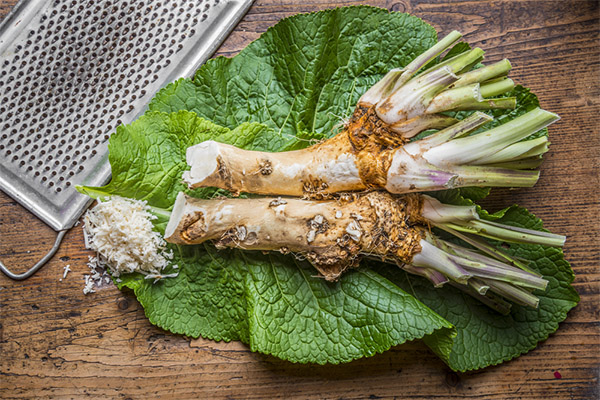
To begin with, we note the energy value of foliage per 100 g of product:
- few calories - 64 kcal:
- the leaf is rich in protein - 9.4;
- there are fats - 1.4;
- there are carbohydrates - 6.28.
The leaves have water, ash and dietary fiber.
We list the main properties of horseradish foliage for a person:
- Helps to cope with the disease faster. Saturates the body with valuable elements, fights viruses and infections.
- Activates and normalizes the digestive system. Enhances the desire to eat, i.e. appetite. It is worth noting that, despite this, the plant will be useful for those who follow their figure. To process horseradish will take a lot of energy. It turns out that the energy reserves received from the perennial are used up for its digestion.
- Tones the heart muscle, lowers blood pressure, helps with atherosclerosis and other heart diseases.
- It is not for nothing called a natural antibiotic. It is so indeed. Horseradish is able to destroy harmful microbes in the human body and prevent their further spread.
- Relieves inflammatory symptoms both inside and out.
- Cleanses the body of toxins.
- Prevents the formation of salt deposits, helps with the regeneration of cartilage and tendons.
- Relieves headache, calms the nervous system, an indispensable tool for insomnia. To do this, just attach the sheet to the temple, hold it for a bit and taste its aroma.
- Useful horseradish for the respiratory tract. For example, an infusion of alcohol is used for sinusitis, and cough and tonsillitis are treated with broth.
- Helps with problems with the urinary system and other similar diseases. It is considered a diuretic.
We have listed only a part of the positive points that prove the usefulness of culture for human health.
Important! When preparing drinks from horseradish in the winter or in the spring, when the body is in particular need of replenishment of the vitamin-mineral complex, colds or infections can be avoided.
For women
Horseradish for a woman is useful in almost everything, and most importantly - normalizes the digestive system. As you know, a woman always strives to be fit and look good. Masks with horseradish can get rid of pigmentation on the face, eliminate freckles.
Recall that the product is low-calorie, but very useful. Therefore, it can be added to salads, any main dishes, soups, etc.
During pregnancy and lactation, you will have to cross out horseradish from your diet!
For men
It is proved that horseradish is able to help with problems with male strength. To do this, it is better to take tincture - the most common form of a healing agent. But the prepared "potion" must be made from fresh products. Dried here will not work.
Simple recipes for preparing a medicinal composition from horseradish:
- We take 0.5 kg of fresh rhizome, grind it in a combine or meat grinder. Spread the crushed parts in a jar, preferably a glass one and pour boiling water. It will take about 1.5 liters. Close the lid, shake the contents of the container and insist 7 days in a dark place. After time, we get the liquid, add honey to it at the rate of 0.5 kg, again shake all the contents and insist for another week. Filter the prepared potion is not worth it. It is better to drink one tablespoon before a meal. It is enough to take “medicine” 2-3 times a day. The infusion should be shaken regularly so that the settled particles also participate in the process.
- We take 1 liter of vodka and a glass of grated horseradish, freshly squeezed carrot, beetroot juice, honey. All mix or shake. We are sent to a dark place for insisting for 14 days. Take the same as in the previous recipe: a spoon before a meal. This tincture is contraindicated for persons with gastrointestinal problems.
Another important argument for including horseradish in the diet of men is the ability of a perennial to protect the heart and normalize the work of the heart muscle.
When losing weight
Horseradish can help with weight loss. It has a sufficient amount of fiber, thanks to which the feeling of hunger will go away. But, and the most important argument in favor of a perennial is its low calorie content!
Thanks to the use of the plant in food, digestion is normalized, which is important for people who often spend fasting days or those who prefer diets.
Cooking Application
In culinary dishes, not only leaves are used, but also horseradish rhizome. Usually, leaves are used for pickling or pickling various vegetables, if they are fresh. They are also added to salads, soups, sauces, etc. Dried herbs are used as seasoning.
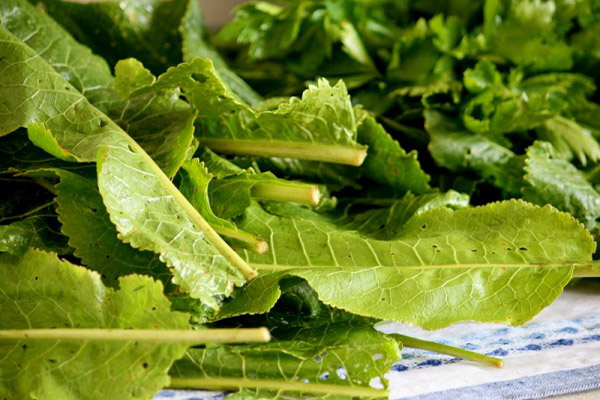
The plant is in perfect harmony with vegetables, meat, fish, etc. Its bitter and pungent taste will give the soup a twist. For those who like hotter food, you can mix the chopped perennial leaves with mustard, garlic and pepper.
Traditional seasoning can not do without a root, which gives the dish a piquant and spicy taste. Each country has its own cooking recipe, which is kept in the strictest confidence. If we talk about Russian cuisine, vinegar is not added to the seasoning, but in Lithuania, on the contrary, vinegar is preferred.
In our country, horseradish is mainly used as a seasoning. But there are lovers of salads with the addition of chopped greens and the root of the plant. From the grated horseradish rhizome, mixed with apples, carrots and beets, an excellent snack is obtained. Usually it is seasoned with vinegar, sugar is added and salt is at your discretion.
For a diet, a salad of grated in equal parts of the roots of horseradish and celery is suitable. This appetizer is seasoned with vegetable or olive oil.
Delicious get horseradish with sour cream. You need to grate the rhizome of the vegetable, add sour cream, sugar to taste and salt as you wish.
The recipe for salted cucumbers
- We wash the cucumbers and put them in a small container to the bottom. Pour vegetables with water and insist for at least 2 hours. It is very important that they become saturated with moisture and become crispy after salting.
- Cooking spices. We clean the garlic and cut the cloves in half. Hot pepper (red) and horseradish rhizome are washed, cleaned and cut into arbitrary pieces of medium size.
- We get the dishes, on the bottom of which we spread the washed greens: dill, parsley, etc. We spread chopped garlic, horseradish and pepper there.
- We lay cucumbers on top with a dense layer, close to each other. From above we cover vegetables with new greens.
- Repeat the process until there is room in the bowl. The last layer should consist of greenery.
- Cooking brine. To do this, pour 1 liter of water into the pan, pour 2 tablespoons of salt into it. We look at the dishes in which the cucumbers were placed. If there are several vegetable layers and the container is quite capacious, then it is clear that much more liquid is required. To prepare more brine, consider the ratio of salt to water. It is important that the prepared brine completely covers all the ingredients. The salt should dissolve in water. If the solution is cold, then thoroughly mix the brine so that no salt grains remain on the bottom.
- Pour vegetables and cover them with horseradish foliage on top. The brine can be used both hot and cold. It all depends on your tastes and preferences.
- Vegetables are pickled for 3 days. But you can take a sample in a day. Perhaps the cucumbers salted properly, and they can already be consumed as food.
- We spread the vegetables on the dish and serve to the guests.
Horseradish leaves in folk medicine
Healers often use foliage and horseradish roots in their practice. Of these, infusions, decoctions are prepared, used fresh.
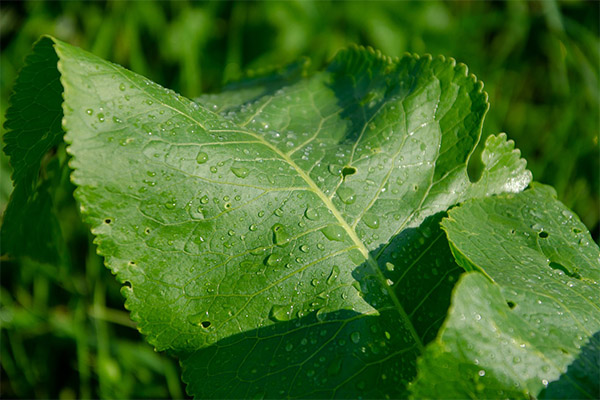
We’ll tell you some secrets.
Compress
It is made both from a solid sheet, and from crushed. For example, to get rid of salt deposits, it is necessary to pour boiling water over the leaf and let it cool. Then attach it to the problem area, wrap it with a warm towel or any cloth and keep the night in this condition.
Scalded leaves can be applied to aching joints to relieve pain and improve the condition.
Bathing with foliage
Take no more than 15 leaves of the plant, pour them 10-12 liters of hot water and insist for a day, after covering the container with a lid.
Pour 2-3 liters of infusion into the prepared bath. Soak in the bath for 30 minutes. It is not recommended to eat before the procedure an hour before and after. Water should not be made very hot. Such procedures help patients with osteochondrosis.
With osteoporosis
With this disease, you should smear the affected areas with tincture of young foliage on vodka.
With neuralgia
Only fresh leaflets of horseradish are used. To begin with, they must be washed and slightly dried. You can apply wet foliage to problem areas for at least 15 minutes.
With varicose veins
A great way to get rid of varicose veins. To do this, remove the stem from the leaves so that they become malleable. Rinse the foliage in advance and let it dry. Apply greens alternately with an overlap, making a leaf dressing, on sites with varicose manifestations. Put a gauze bandage on top and put on knee-high socks or long socks. An elastic bandage can be used, but they should not be rewound tightly. In this condition, leave the compress overnight.
With mastopathy
To treat this disease, tinctures from rhizomes are used, not foliage.
For lumbar pain
It will help get rid of intolerable pains in the lumbar region, tincture of vodka from horseradish foliage. For such a solution, it is necessary to collect young leaves in the spring - in May. To get rid of pain, rub the leaves of the lower back overnight.
Types of healing compounds
Infusion
Pour washed and dried leaflets of horseradish with boiling water per 5 pcs. foliage - 3 l of water. Close the dishes with a lid and send to stand in the refrigerator for a day. Take half an hour before dinner, breakfast and lunch.
Tincture
Grind previously washed and dried horseradish leaves. Put the resulting gruel in a glass container. Pour vodka over everything. Close the jar and insist for a week in the refrigerator.
After the time, get the tincture, strain it and start taking it at the rate. You should drink 1 tablespoon before meals, about 30 minutes. To improve the taste of tinctures and enhance the effectiveness of treatment, you can squeeze juice from fresh lemon there or add a little honey.
Decoction
The word broth speaks for itself. Have to cook horseradish foliage. First rinse all leaves, dry and finely chop. Pour boiling water over boiling water. For 25 g of leaves 550-600 ml of water will be required. Put the pot on the fire and bring to a boil again. Remove from heat and cool at room temperature. Use the decoction as follows: moisten gauze in it and attach to the diseased part of the body. Helps with knee pain caused by arthrosis.
Tea
To make tea, you need to pour boiling water on the leaves and add sugar to them. It is better if honey is used instead of sugar. The taste will improve the juice of fresh lemon.
Ointment
To prepare the ointment, you need a blender, but you can use a food processor or a meat grinder to grind. Grind horseradish foliage with apple. Proportions to take equal. Mix everything and immediately apply to problem areas.
An excellent ointment is obtained from horseradish, turnip and radish mixed in equal parts. With this ointment, treat diseased areas up to 3 times per day.
Application in cosmetology
Horseradish foliage is equally beneficial for both skin and hair. Below are a few recipes for masks that are very simple to cook at home and rejuvenate your face, as well as restore the former shine of hair.
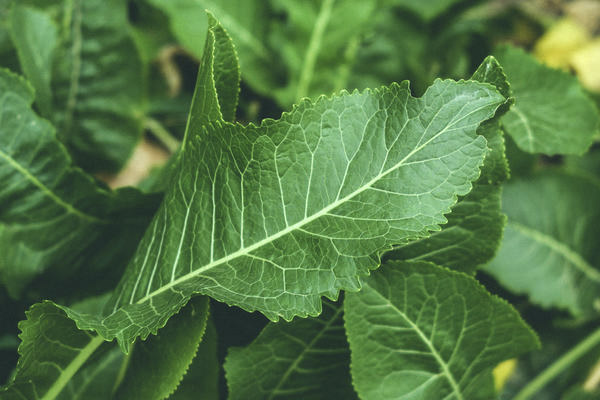
For aging skin
Thanks to this mask, the face will become toned, small wrinkles and the first signs of aging will disappear.
You need to grind the leaves of the following plants in a separate bowl:
- horseradish;
- plantain;
- yarrow.
Take everything in equal proportions! Stir them and pour boiling water. Allow the solution to infuse and wait at least 10 minutes. Then drain the water, leaving only the pulp from the greens.
To apply it on the face previously cleared of cosmetics. The duration of the mask is 20 minutes. Rinse off with cool water and apply a moisturizing or softening cream to the skin. The mask tightens the skin, removes bryl, refreshes and rejuvenates.
With cellulite
Grind the horseradish leaves to a state of gruel, add the same portion of cream to them. Cream must be fat, at least 20%. Mix everything and pour oatmeal. The number of flakes is equivalent to two parts. Bring the mixture to uniformity and apply in circular massaging movements to problem areas. Wrap the body on top with cling film and hold for at least 20 minutes. Then rinse everything off with a little warm water and grease with cream. It is better to use creams based on citrus essential oils, then the effect of the procedure will be immediately visible.
Such wraps can be done 3 or 4 times a week, but not every day. Alternate the procedure after a day. To completely get rid of the problem, you need to make at least 10 wraps. You can increase the effectiveness if you apply the prepared composition to steamed skin areas after peeling.
For hair growth
Prepare 3 leaflets of horseradish, 40 g of fat sour cream, 15 drops of essential oil. For this mask, you need a pinch of dry nettle.
To start, turn the horseradish foliage into pulp, i.e. chop, add sour cream with butter, mix well. Apply a homogeneous mass to the hair, wrap with a film and hold for 40 minutes. Rinse with cooked nettle infusion. It will require warm water and dry nettles per 2 cups of liquid - 1 tablespoon of dry herbs.
Regularly conducting such procedures will accelerate growth and saturate the hair with moisture.
To get rid of the cut ends
It will be required to prepare the mask:
- horseradish foliage - 8 leaves;
- egg - 3 pcs.;
- essential oil - 4 drops.
Oil can be anything. To start, grind the leaves, add eggs and butter beaten in advance to them. Stir and apply on the problem tips. It can be distributed over all hair to prevent cross-section. Cover the hair with a film and a warm towel. Wait at least an hour and rinse with warm water. To achieve greater efficiency, you need to apply special cosmetic oil on the ends.
For dry hair
Have to take:
- horseradish leaves - 5 pcs.;
- sandalwood oil - 10-12 drops;
- brewer's yeast - 25 g;
- black tea without additives.
Rinse leaves, dry and grind into pulp. Add butter and yeast to them. Brew tea (the amount will depend on the length and density of the hair) and dilute the mixture with it. Apply the resulting composition to the hair, cover with polyethylene and wait about 20 minutes. Rinse under a stream of warm water.
This mask will not only moisturize your hair, but also restore its former shine.
Can rabbits and chickens be given horseradish leaves
Giving foliage is not prohibited, but even useful. In horseradish, a sufficient amount of useful elements that are necessary for pets to improve digestion. According to experienced farmers, the best option for feeding is the preparation of mixtures from different herbs. Not all animals will enjoy single horseradish foliage, as it will be bitter in taste.
Remember that animal feed should be not only nutritious, but also beneficial. This is the basis of good health, which means tasty meat and high-quality fur.
Contraindications
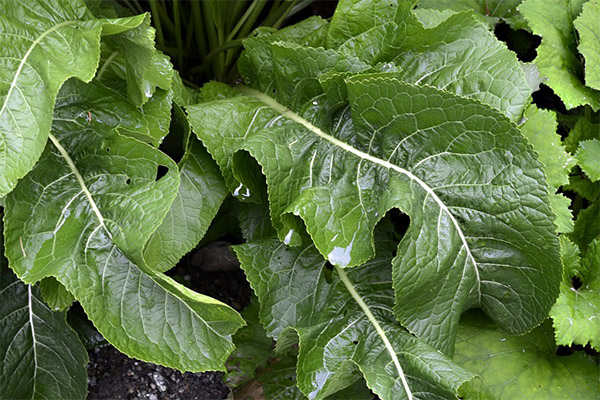
You should be careful with horseradish or even exclude it from the diet:
- pregnant
- breastfeeding mothers;
- sick stomach ulcer;
- with kidney problems;
- when inflammation occurs in the digestive organs and system;
- children under 5 years old.
The plant can not be eaten in large quantities. You can eat it every day, but little by little. Abuse leads to irreversible consequences, such as stomach problems, increased pressure, bleeding, etc.
«Important: all information on the site is provided exclusively in fact-finding purposes. Before applying any recommendations, consult with a profile specialist. Neither the editors nor the authors are liable for any possible harm caused materials. "

